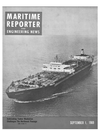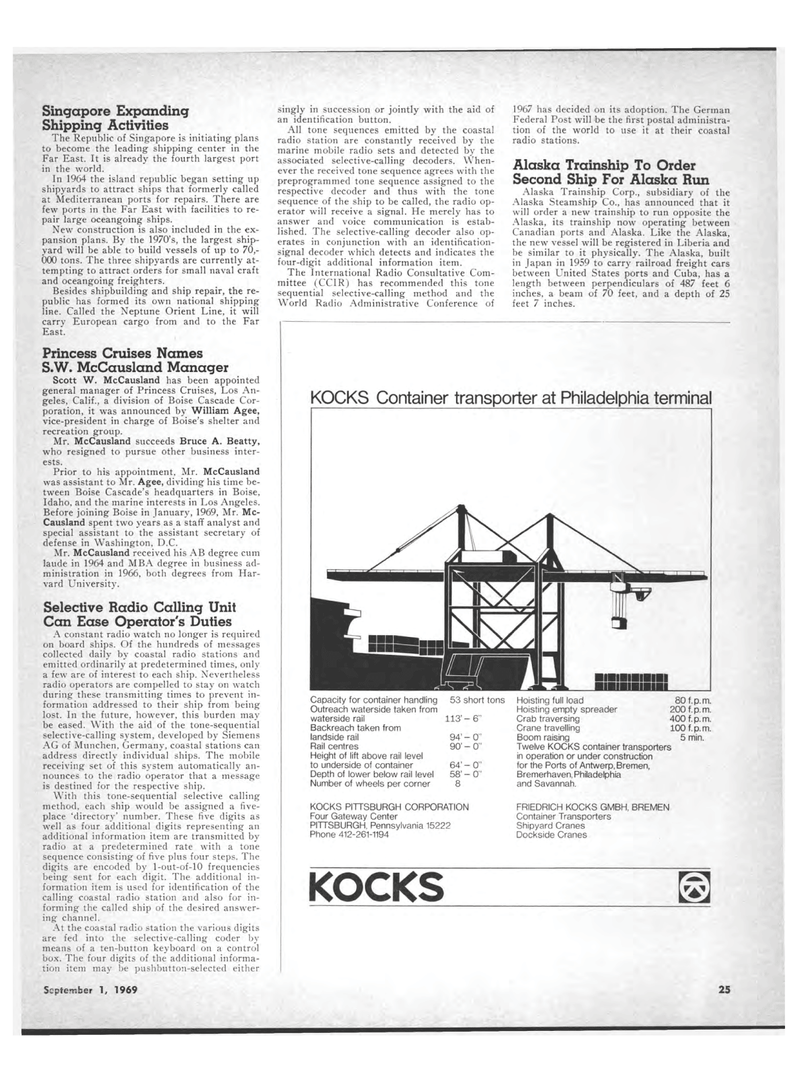
Page 23: of Maritime Reporter Magazine (September 1969)
Read this page in Pdf, Flash or Html5 edition of September 1969 Maritime Reporter Magazine
Singapore Expanding Shipping Activities The Republic of Singapore is initiating plans to become the leading shipping center in the Far East. It is already the fourth largest port in the world. In 1964 the island republic began setting up shipyards to attract ships that formerly called at Mediterranean ports for repairs. There are few ports in the Far East with facilities to re-pair large oceangoing ships. New construction is also included in the ex-pansion plans. By the 1970's, the largest ship-yard will be able to build vessels of up to 70,-000 tons. The three shipyards are currently at-tempting to attract orders for small naval craft and oceangoing freighters. Besides shipbuilding and ship repair, the re-public has formed its own national shipping line. Called the Neptune Orient Line, it will carry European cargo from and to the Far East. Princess Cruises Names S.W. McCausland Manager Scott W. McCausland has been appointed general manager of Princess Cruises, Los An-geles, Calif., a division of Boise Cascade Cor-poration, it was announced by William Agee, vice-president in charge of Boise's shelter and recreation group. Mr. McCausland succeeds Bruce A. Beatty, who resigned to pursue other business inter-ests. Prior to his appointment, Mr. McCausland was assistant to Mr. Agee, dividing his time be-tween Boise Cascade's headquarters in Boise, Idaho, and the marine interests in Los Angeles. Before joining Boise in January, 1969, Mr. Mc-Causland spent two years as a staff analyst and special assistant to the assistant secretary of defense in Washington, D.C. Mr. McCausland received his AB degree cum laude in 1964 and MBA degree in business ad-ministration in 1966, both degrees from Har-vard University. Selective Radio Calling Unit Can Ease Operator's Duties A constant radio watch no longer is required on board ships. Of the hundreds of messages collected daily by coastal radio stations and emitted ordinarily at predetermined times, only a few are of interest to each ship. Nevertheless radio operators are compelled to stay on watch during these transmitting times to prevent in-formation addressed to their ship from being lost. In the future, however, this burden may be eased. With the aid of the tone-sequential selective-calling system, developed by Siemens AG of Munchen, Germany, coastal stations can address directly individual ships. The mobile receiving set of this system automatically an-nounces to the radio operator that a message is destined for the respective ship. With this tone-sequential selective calling method, each ship would be assigned a five-place 'directory' number. These five digits as well as four additional digits representing an additional information item are transmitted by radio at a predetermined rate with a tone sequence consisting of five plus four steps. The digits are encoded by l-out-of-10 frequencies being sent for each digit. The additional in-formation item is used for identification of the calling coastal radio station and also for in-forming the called ship of the desired answer-ing channel. At the coastal radio station the various digits are fed into the selective-calling coder by means of a ten-button keyboard on a control box. The four digits of the additional informa-tion item may be pushbutton-selected either singly in succession or jointly with the aid of an identification button. All tone sequences emitted by the coastal radio station are constantly received by the marine mobile radio sets and detected by the associated selective-calling decoders. When-ever the received tone sequence agrees with the preprogrammed tone sequence assigned to the respective decoder and thus with the tone sequence of the ship to be called, the radio op-erator will receive a signal. He merely has to answer and voice communication is estab-lished. The selective-calling decoder also op-erates in conjunction with an identification-signal decoder which detects and indicates the four-digit additional information item. The International Radio Consultative Com-mittee (CCIR) has recommended this tone sequential selective-calling method and the World Radio Administrative Conference of 1967 has decided on its adoption. The German Federal Post will be the first postal administra-tion of the world to use it at their coastal radio stations. Alaska Trainship To Order Second Ship For Alaska Run Alaska Trainship Corp., subsidiary of the Alaska Steamship Co., has announced that it will order a new trainship to run opposite the Alaska, its trainship now operating between Canadian ports and Alaska. Like the Alaska, the new vessel will be registered in Liberia and be similar to it physically. The Alaska, built in Japan in 1959 to carry railroad freight cars between United States ports and Cuba, has a length between perpendiculars of 487 feet 6 inches, a beam of 70 feet, and a depth of 25 feet 7 inches. KOCKS Container transporter at Philadelphia terminal Capacity for container handling Outreach waterside taken from waterside rail Backreach taken from landside rail Rail centres Height of lift above rail level to underside of container Depth of lower below rail level Number of wheels per corner 53 short tons 113'- 6" 94' - 0" 90' - 0" 64' - 0" 58' - 0" Hoisting full load Hoisting empty spreader Crab traversing Crane travelling Boom raising 80 f.p.m. 200 f. p. m. 400 f. p. m. 100 f. p. m. 5 min. Twelve KOCKS container transporters in operation or under construction for the Ports of Antwerp, Bremen, Bremerhaven, Philadelphia and Savannah. KOCKS PITTSBURGH CORPORATION Four Gateway Center PITTSBURGH, Pennsylvania 15222 Phone 412-261-1194 FRIEDRICH KOCKS GMBH, BREMEN Container Transporters Shipyard Cranes Dockside Cranes KOCKS © September 1, 1969 25

 22
22

 24
24
